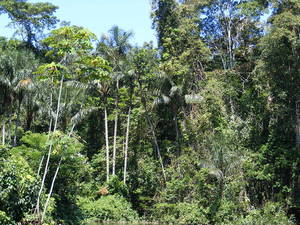In a massive study scientists have shown that climate change could turn the Amazon rainforest from a carbon ally into a carbon criminal.
Writing in this week's Science Leeds University ecologist Professor Oliver Phillips, together with an international team of more than 60 collaborators, describes how he and his colleagues have studied 136 "plots" of rainforest to understand the impact of future climate change on the ability of the Amazon to soak up CO2. Specifically the team compared how the plots performed historically with the effect of a prolonged drought in 2005.
 "We measured trees and wood density to calculate how much biomass was present," says Phillips. The team found that in years leading up to 2005 the Amazon was a powerful carbon "sink", locking away more than a tonne of carbon per hectare per year.
"We measured trees and wood density to calculate how much biomass was present," says Phillips. The team found that in years leading up to 2005 the Amazon was a powerful carbon "sink", locking away more than a tonne of carbon per hectare per year.
But the drought led to the death of trees and growth arrest, turning what was a carbon sink into a carbon source with areas losing up to 2 tonnes of carbon (as carbon dioxide due to breakdown of the wood and foliage) per hectare per year.
The significance of this result is that the 2005 drought was provoked by warmer-than-normal north Atlantic water, which also triggered Hurricane Katrina and led to the flooding parts of New Orleans. But it had the reverse effect over the Amazon, and if global warming continues we might therefore see a drier Amazon more often. This would mean that the billions of tonnes of carbon locked away by the rainforest every year would cease to be removed from the atmosphere and at the same time the Amazon would become a net producer of carbon. The affect would be a dramatic acceleration of the greenhouse effect, with predictable global consequences.
"This should provoke a re-think of the political agenda," says Phillips.









Comments
Add a comment